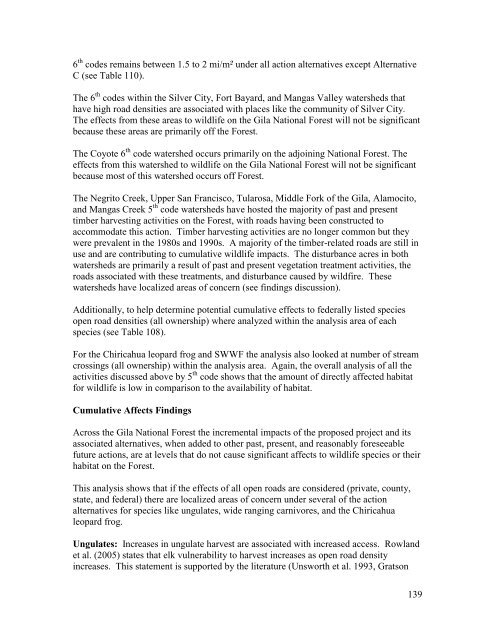Wildlife Specialist report
Wildlife Specialist report
Wildlife Specialist report
You also want an ePaper? Increase the reach of your titles
YUMPU automatically turns print PDFs into web optimized ePapers that Google loves.
6 th codes remains between 1.5 to 2 mi/m² under all action alternatives except Alternative<br />
C (see Table 110).<br />
The 6 th codes within the Silver City, Fort Bayard, and Mangas Valley watersheds that<br />
have high road densities are associated with places like the community of Silver City.<br />
The effects from these areas to wildlife on the Gila National Forest will not be significant<br />
because these areas are primarily off the Forest.<br />
The Coyote 6 th code watershed occurs primarily on the adjoining National Forest. The<br />
effects from this watershed to wildlife on the Gila National Forest will not be significant<br />
because most of this watershed occurs off Forest.<br />
The Negrito Creek, Upper San Francisco, Tularosa, Middle Fork of the Gila, Alamocito,<br />
and Mangas Creek 5 th code watersheds have hosted the majority of past and present<br />
timber harvesting activities on the Forest, with roads having been constructed to<br />
accommodate this action. Timber harvesting activities are no longer common but they<br />
were prevalent in the 1980s and 1990s. A majority of the timber-related roads are still in<br />
use and are contributing to cumulative wildlife impacts. The disturbance acres in both<br />
watersheds are primarily a result of past and present vegetation treatment activities, the<br />
roads associated with these treatments, and disturbance caused by wildfire. These<br />
watersheds have localized areas of concern (see findings discussion).<br />
Additionally, to help determine potential cumulative effects to federally listed species<br />
open road densities (all ownership) where analyzed within the analysis area of each<br />
species (see Table 108).<br />
For the Chiricahua leopard frog and SWWF the analysis also looked at number of stream<br />
crossings (all ownership) within the analysis area. Again, the overall analysis of all the<br />
activities discussed above by 5 th code shows that the amount of directly affected habitat<br />
for wildlife is low in comparison to the availability of habitat.<br />
Cumulative Affects Findings<br />
Across the Gila National Forest the incremental impacts of the proposed project and its<br />
associated alternatives, when added to other past, present, and reasonably foreseeable<br />
future actions, are at levels that do not cause significant affects to wildlife species or their<br />
habitat on the Forest.<br />
This analysis shows that if the effects of all open roads are considered (private, county,<br />
state, and federal) there are localized areas of concern under several of the action<br />
alternatives for species like ungulates, wide ranging carnivores, and the Chiricahua<br />
leopard frog.<br />
Ungulates: Increases in ungulate harvest are associated with increased access. Rowland<br />
et al. (2005) states that elk vulnerability to harvest increases as open road density<br />
increases. This statement is supported by the literature (Unsworth et al. 1993, Gratson<br />
139
















